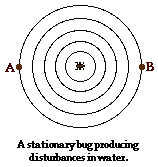The Doppler effect (or Doppler shift), named after the Austrian physicist Christian Doppler, who proposed it in 1842 in Prague, is the change infrequency of a wave (or other periodic event) for an observer moving relative to its source. It is commonly heard when a vehicle sounding a siren or horn approaches, passes, and recedes from an observer. The received frequency is higher (compared to the emitted frequency) during the approach, it is identical at the instant of passing by, and it is lower during the recession. 
here is a happy bug in the center of a circular water puddle. The bug is periodically shaking its  legs in order to produce disturbances that travel through the water. If these disturbances originate at a point, then they would travel outward from that point in all directions. Since each disturbance is traveling in the same medium, they would all travel in every direction at the same speed. The pattern produced by the bug's shaking would be a series of concentric circles as shown in the diagram at the right. These circles would reach the edges of the water puddle at the same frequency. An observer at point A (the left edge of the puddle) would observe the disturbances to strike the puddle's edge at the same frequency that would be observed by an observer at point B (at the right edge of the puddle). In fact, the frequency at which disturbances reach the edge of the puddle would be the same as the frequency at which the bug produces the disturbances. If the bug produces disturbances at a frequency of 2 per second, then each observer would observe them approaching at a frequency of 2 per second.
legs in order to produce disturbances that travel through the water. If these disturbances originate at a point, then they would travel outward from that point in all directions. Since each disturbance is traveling in the same medium, they would all travel in every direction at the same speed. The pattern produced by the bug's shaking would be a series of concentric circles as shown in the diagram at the right. These circles would reach the edges of the water puddle at the same frequency. An observer at point A (the left edge of the puddle) would observe the disturbances to strike the puddle's edge at the same frequency that would be observed by an observer at point B (at the right edge of the puddle). In fact, the frequency at which disturbances reach the edge of the puddle would be the same as the frequency at which the bug produces the disturbances. If the bug produces disturbances at a frequency of 2 per second, then each observer would observe them approaching at a frequency of 2 per second.



